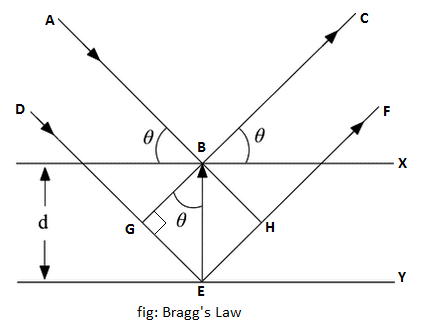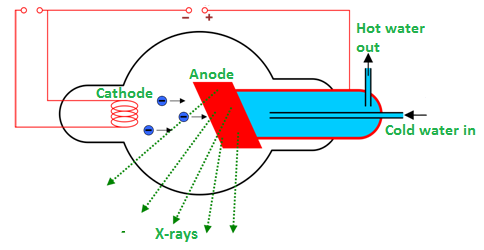Bragg's Law
Bragg's LawSir William Bragg and his son Sir Lawrence Bragg studied the diffraction of X-rays in detail and devised a method for determining the wavelength of X-rays. Lawrence Bragg considered that...

 It is an electromagnetic wave of high energy and very short wavelength, which is able to pass through many materials opaque to light.
It is an electromagnetic wave of high energy and very short wavelength, which is able to pass through many materials opaque to light.
Production of x-rays
X-rays are produced when the electrons are suddenly decelerated upon collision with the metal target; these x-rays are commonly called bremsstrahlung or "braking radiation". If the bombarding electrons have sufficient energy, they can knock an electron out of an inner shell of the target metal atoms.
A modern x-ray tube called Coolidge tube is used to produce an X-ray.
Coolidge tube

In the Coolidge tube, the electrons are produced by a thermionic effect from a tungsten filament heated by an electric current. The filament is the cathode of the tube. The high voltage potential is between the cathode and the anode, the electrons are thus accelerated and then hit the anode.
If V is the accelerating voltage applied between the cathode and the anode then the kinetic energy gained by the electron is,
eV=1/2
Control of intensity and quality of x-rays
This depends upon the electric current flowing through the filament. So by controlling the current with the help of rheostat, we can control the intensity of X-rays. Hence, the intensity of the can be changed by adjusting the filament current.
The intensity of X-rays depends upon the number of electrons emitted from the filament. This depends upon the electric current flowing through the filament. ... Therefore, the quality of X-rays depends upon their energy which, in turn, depends upon the kinetic energy of the incident electrons.
Properties of x-rays
• They ionize the gas through which they pass.
•They effect photographic plates.
• They deflect in electric and magnetic fields.